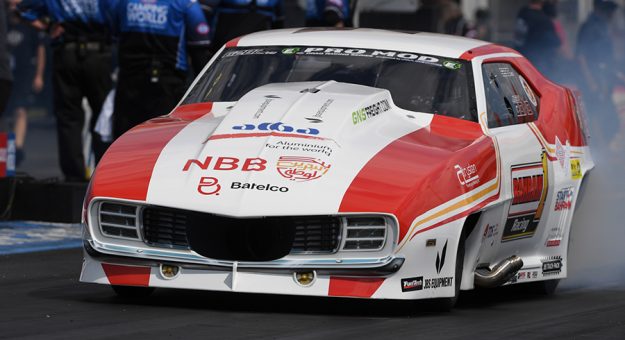SNOHOMISH, Wash. — Jason Fiorito, president of Seattle’s Pacific Raceways, has raced stock cars for years and he assumed his son would want to follow in his footsteps. But the teenager prefers Miatas and BMWs and sports car racing in the Northwest’s Pro 3 Series.
The surprised dad said, “I’m thinking, ‘I love my kid for wanting to be in the sport.’ I don’t have to shove a stock car down his throat. That’s my thing.”
And Fiorito sees a parallel between his situation and the NHRA’s as it strives to attract a new and younger crowd.
“Similarly, we shouldn’t be shoving our idea of what drag racing is down our customers’ throats. We should be listening to them about what they want to see,” Fiorito said. “And they’re speaking pretty clearly through viewership on TV and attendance at races that they want to see something different than what we’ve been presenting to them for the last 60-some years.
“I’m not smart enough to figure out what it should be. I’m just smart enough to figure out that if we don’t start paying attention and we don’t start evolving that we’re all going to hear crickets chirping and we’re going to see weeds growing up through drag strips,” he continued.
“I think there’s a hesitancy, out of respect for the history of the sport, to pay respect to what brought us here. But I think there are opportunities to (do that) while embracing what Americans are getting behind,” Fiorito said. “That ‘Pinks’ phenomenon segued into ‘No Prep Kings’ and ‘Street Outlaws.’ That’s hugely popular and it’s a well-attended event. If we’re just going to have an industry watch this happen without learning anything from it, we’re doing ourselves, our fans, our competitors and the sport a disservice.”
Jeffrey Young, NHRA’s vice-president of marketing and communications, said the sanctioning body is listening: “Our tag line is ‘Speed for All.’ We’re an inclusive sport. We want everyone to be a part of it. There are all kinds of different types of racing and we want them to come to our member tracks.”
The NHRA took a step toward wooing more manufacturers and racers in late April, announcing the establishment of a developing EV class for its nationwide grassroots bracket series.
A few weeks before that, a couple of “Street Outlaws” racers visited the NHRA event at Las Vegas as spectators and indicated they enjoyed the sensory-overload experience.
In September 2016, “Street Outlaws” kingpin Justin Shearer ran into the more buttoned-down, mainstream NHRA, hoping to qualify for the U.S. Nationals. The startling reality for him was that, unlike his cable-TV reality show “Street Outlaws,” he wasn’t a chief at all.
Instead, he was one of 33 Pro Mod warriors, off the starting grid at 31st out of 33, to be precise — after sinking about $40,000 into his ’68 Firebird to bring it within the rules.
“There are a lot of things I had to change on my car; things I thought were safe, things I thought were fine, things I thought were going to be OK. I thought my car was super-safe,” Shearer said. For him, that weekend was humbling, expensive and an absolute blast.
Most of all, he learned the NHRA is unmatched in its structure for safety. In turn, Shearer showed veteran NHRA drag racers how to mix passion, pocketbook and a puckish dose of fun.
It’s clear the establishment and “the disruptors” can learn from one another. What’s essential is that both sides get together to preserve the sport.
That’s what Fiorito was talking about: Younger prospective NHRA fans “want to see us evolve. And if we don’t evolve, we’re going to miss the boat on this deal.”
At Pacific Raceways, Fiorito has seen the popularity of high-school drags wane and interest in import events increase.
“There’s a big percentage of kids just not into the ’68 Camaros anymore,” Fiorito explained. “They’re into the cars they grew up around, and that revolves around the import crowd.”
Still, Fiorito knows NHRA has a lot to offer.
“There are always going to be that following for the fuel cars,” he said. “They’re mesmerizing, to me. I never get sick of watching fuel cars.
“We’ve got a great show — don’t get me wrong. Showing up and spending a weekend with the NHRA is the biggest bang for your buck as a racing spectator. I’m not saying we don’t have a great product,” he noted. “I’m saying there are things going on here to which we need to be paying attention. We need to be talking about how this sport is going to evolve over the next five or 10 years. We can’t sit back as track operators or sanctioning bodies and think that the show that sold 40 years ago is going to sell 40 years from now. We have to be open to looking at new opportunities.”
Young expressed a genuine desire to discuss any feasible proposals.
Fiorito said, “I know these ships are hard to turn around. This doesn’t happen overnight. I’m not blaming the NHRA. You can’t follow every fad that comes down the pike. I’m just suggesting that, ‘Hey, let’s take a look at what has been successful over the last decade.’ Drawing millions and millions of fans on TV and tens of thousands of fans at the facility is a little bit different than the model the NHRA shows up with. There are some things to learn there.”
